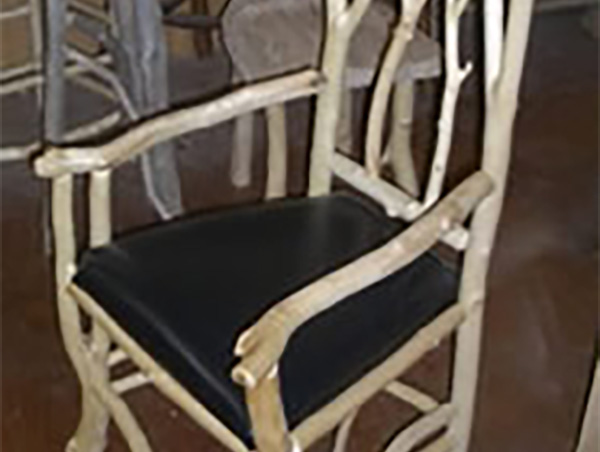
If you asked Daniel Mack whether he makes furniture, architectural detail, or sculpture…his answer would be “yes.” That’s because Daniel’s pieces work on all three levels. You can sit comfortably down to dinner on one of his chairs. One of his pieces might hold up the roof of your house. And then again, one of his chairs may be displayed in your living room like a work of art.
Working from his shop in Warwick, New York — about 60 miles from New York City — he creates what he calls rustic furnishings. Each piece has a home-made, country furniture look … like he went out into the woods, gathered what material he could find, and then made it fit together into a chair, or a table, or a bed, or a handrail, or a pergola!
“I started making and selling the chairs in 1978,” Daniel recalled, “At first, I didn’t sell that many, but the people who did buy them got so excited about the piece, that it got me thinking. And it dawned on me that to some people, the chairs represented the romance of the forest … something they wanted to bring into their house or a room they were doing.”
That recognition helped Daniel understand that his business was not that of a small factory trying to turn out as many chairs as possible, but in creating special objects. It also gave him license to explore other things that led to his more sculptural work … and to just play around! Since then Daniel’s work has gone in three directions: architectural detail, a series of personal works he calls fetishes, and of course, furniture.
His architectural work uses natural tree forms for projects ranging from railings and pergolas to supportive columns. He’s currently working on a roof-supporting structure made up of forty, two-foot diameter cedar trees. The trees were cut to include some of the root structure, so they’ll look like they’re growing out of their granite bases. Daniel expects this project to take a year.
Partly as a counter balance to this precise, structural architectural work, Daniel started to create smaller, personal items. These “fetishes” are ephemeral pieces that he describes as almost shamanistic and extend the spiritual side of his work. And yes, he still creates dining room chairs that have to be a certain height and certain tip. The fact that he’s concerned about function and utilitarian quality makes him identify himself as more of an artisan than an artist.
“I’ve never broken those rules,” he noted. “That’s why I consider myself to be more an artisan than an artist. My chairs still look and function as chairs, but then I put a spin on them that makes them special. The look is sometimes called “magic realism”…where you take the ordinary and make it extraordinary.”
He tries to use the most common wood possible…usually volunteer maple trees…which he takes down live and dries out for 8 to 16 weeks. Though he started out using traditional hand tools, he soon found the process too time consuming to make a living. So now he uses as many power tools, cordless if possible, as he needs. In his philosophy, you don’t have to do hand-joining to make a rustic chair … the key part is what happens to the trees. To finish a piece, he’ll lightly sand it and put on a linseed oil/turpentine mix and then wax over that. The final appearance looks rough, but it is solid and smooth to the touch.
“It looks like it’s going to fall apart it, but it’s really solid. It looks like a tree, but it’s a chair.”
Over the years, Daniel has written four books, one on log cabins, and three on rustic furniture. He’s currently working on a book on Adirondack chairs. And when he teaches courses at craft schools and art centers around the country, he covers both technique and philosophy.
“When I went looking for advice on doing this kind of work in the late 70s, there were only about three people in the country who did this … and they were all nasty hermits, corporate burnouts who told the world to go to hell. John Alexander’s book “How To Make a Chair From a Tree” was helpful, but I really had to teach myself, adapting what was basically country woodworking. And I also made a promise that whatever I learned I would share with others. That’s where my books and commitment to teaching came from.”
That’s also the reason behind the Woodlanders Gathering, coming up in July in Wisconsin. Daniel organized the annual get-together, for mid-career woodworkers. Anyone who’s willing to talk and share ideas is welcome and between 100 and 125 people attend what is essentially a family picnic.
What’s ahead? Daniel plans to do more of his architectural and personal work. But the final purpose of his work will be up to his customers.
“My work isn’t really done until they own it.” He explained, “I am more the steward of it, rather than the creator. It started out in the forest, spent some time in my workshop, then it finally became part of someone’s family.”
Visit Daniel Mack’s website.





